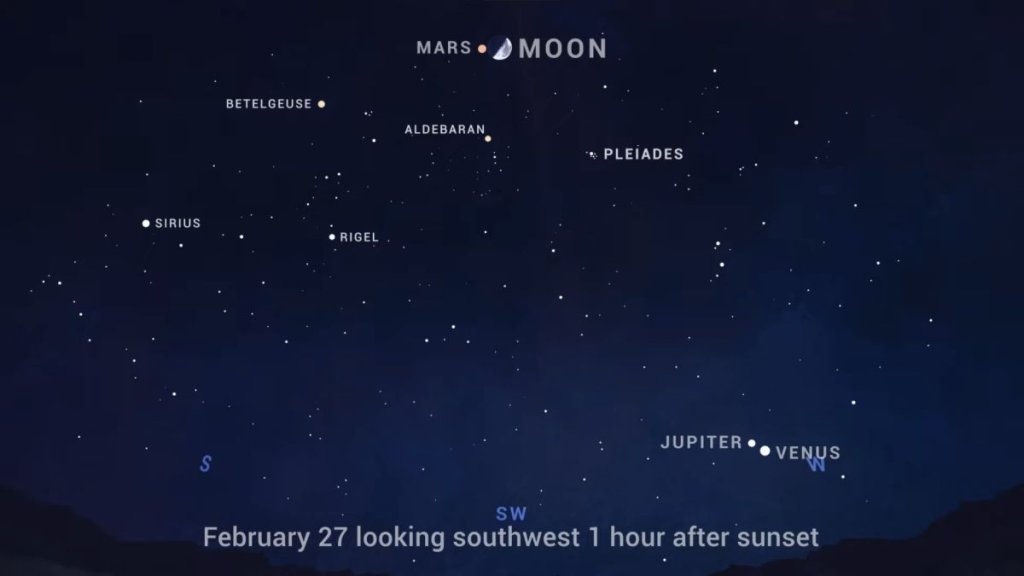
See the half moon pass by Mars in the sky tonight (Image Credit: Space.com)
The moon and Mars will make for a nice spectacle in the night sky tonight.
According to calendars and almanacs, Monday evening (Feb. 27) bring us a first quarter moon. It’s also sometimes called the “half” moon, although as darkness falls across North America, close inspection with binoculars or a small telescope will reveal that there is actually a little more than half of the moon illuminated by the sun. That’s because the actual moment of first quarter occurred much earlier in the day at 3:06 a.m. EST or 12:06 p.m. PST (0806 GMT).
When it gets sufficiently dark, you’ll also take notice of a rather bright yellow-orange star appearing to the moon’s upper left. That’s not a star, however, but a once brilliant planet that continues to ebb in brightness: Mars. Look for this colorful world shining very high in the southwest in the Taurus constellation during dusk and lower in the west as night grows late.
Related: Night sky, February 2023: What you can see tonight [maps]
Read more: What is the moon phase today? Lunar phases 2023
In fact, if you keep track of this pair during the night, you’ll no doubt notice that the moon will slowly be creeping toward Mars. From the West Coast, they’ll appear closest around 9:00 p.m. (0200 GMT on Feb. 28) while East Coast skywatchers will have to wait until around 1:00 a.m. (0600 GMT) on Tuesday morning, Feb. 28. Meanwhile from Iceland, northern Europe, northern Asia and the Arctic regions will see the moon pass in front of the Red Planet.
Receding and fading

Want to see Mars next to the moon? We recommend the Celestron Astro Fi 102 (opens in new tab) as the top pick in our best beginner’s telescope guide.
Mars will remain prominent all evening, despite the fact that it will continue to slowly fade in the days and weeks to come as it continues to gradually pull away from the earth. When the moon passes it by on Monday, it will be shining at a respectable magnitude +0.4, which is just a bit dimmer than the yellow-white star Procyon in Canis Minor.
But one month from now, Mars will have faded five-tenths of a magnitude, down to +0.9 (the higher the value, the fainter the object), making it practically the same brightness as Spica, the brightest star of Virgo.
Because Mars comes to eastern quadrature — 90-degrees east of the sun — on March 16, it should now appear distinctly gibbous in even a very small telescope all month. Most amateur telescopes won’t be able to resolve any substantial detail on Mars; in fact, by the end of March its apparent diameter will have shrunk to 6.4 arc seconds, which is only about one-third the size Mars appeared to us at the end of November when it was closest to earth at 50.6 million miles (81.4 million km) away.
In contrast, by the end of March, Mars will have receded to a distance of 135 million miles (217.3 million km) from us.

Celestial interactions
Also, by that time, its position will be nearing the big star cluster M35 in Gemini. On Thursday, March 30, Mars will be passing about a degree to the north of the cluster making for a pretty sight in binoculars.
On the North American evening of April 14, avail yourself of another good binocular target: Mars will pass just 13 arc minutes — 0.22 degrees — south of the third magnitude star, Mebsuta. To get an idea of how close that is, that’s less than one-half the apparent width of the moon.
But Mars will be also slowly edging toward the “Twin Stars” of Castor and Pollux and will have an interesting interaction with those two luminaries during the fourth week of April with the moon also getting involved during the evenings of April 25 and 26.
If you’re hoping to catch a glimpse of the moon and Mars individually during the conjunction our guides for the best telescopes are a great place to start. If you want to glimpse the conjunction between the two, Space.com’s best binoculars guide could help you find the right pair.
And if you’re looking to snap photos of the night sky, don’t miss our guides on how to photograph the moon, the best cameras for astrophotography and the best lenses for astrophotography.
Editor’s Note: If you snap the Mars and the moon and would like to share it with Space.com’s readers, send your photo(s), comments, and your name and location to spacephotos@space.com.
Joe Rao serves as an instructor and guest lecturer at New York’s Hayden Planetarium (opens in new tab). He writes about astronomy for Natural History magazine (opens in new tab), the Farmers’ Almanac (opens in new tab) and other publications. Follow us on Twitter @Spacedotcom (opens in new tab) and on Facebook (opens in new tab).





